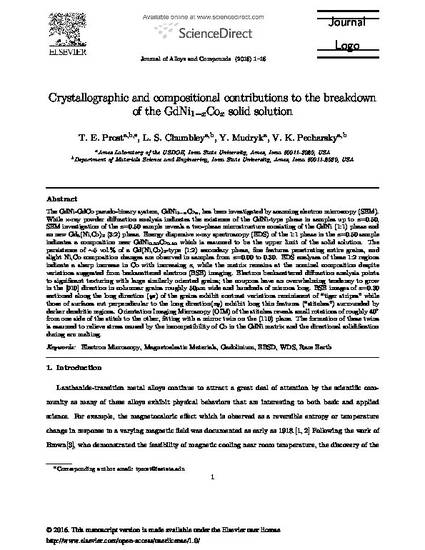
The GdNiGdCo pseudo-binary system, GdNi1−x Cox, has been investigated by scanning electron microscopy (SEM). While x-ray powder diffraction analysis indicates the existence of the GdNi-type phase in samples up to x = 0.50, SEM investigation of the x = 0.50 sample reveals a two-phase microstructure consisting of the GdNi (1:1) phase and a new Gd3(Ni,Co)2 (3:2) phase. Energy dispersive x-ray spectroscopy (EDS) of the 1:1 phase in the x = 0.50 sample indicates a composition near GdNi0.60 Co0.40 which is assumed to be the upper limit of the solid solution. The persistence of ∼ 5 vol% of a Gd(Ni,Co)2-type (1:2) secondary phase, fine features penetrating entire grains, and slight Ni,Co composition changes are observed in samples from x = 0.00 to 0.30. EDS analyses of these 1:2 regions indicate a sharp increase in Co with increasing x, while the matrix remains at the nominal composition despite variations suggested from backscattered electron (BSE) imaging. Electron backscattered diffraction analysis points to significant texturing with large similarly oriented grains; the coupons have an overwhelming tendency to grow in the [010] direction in columnar grains roughly 50 μm wide and hundreds of microns long. BSE images of x = 0.30 sectioned along the long direction (yz) of the grains exhibit contrast variations reminiscent of “tiger stripes” while those of surfaces cut perpendicular to the long direction (xy) exhibit long thin features (“stitches”) surrounded by darker dendritic regions. Orientation Imaging Microscopy (OIM) of the stitches reveals small rotations of roughly 40∘ from one side of the stitch to the other, fitting with a mirror twin on the (110) plane. The formation of these twins is assumed to relieve stress caused by the incompatibility of Co in the GdNi matrix and the directional solidification during arc melting.
Available at: http://works.bepress.com/l_chumbley/66/

This is a manuscript of an article published as Prost, T. E., L. S. Chumbley, Y. Mudryk, and V. K. Pecharsky. "Crystallographic and compositional contributions to the breakdown of the GdNi1− x Cox solid solution." Journal of Alloys and Compounds 696 (2017): 382-390. DOI: 10.1016/j.jallcom.2016.11.312. Posted with permission.